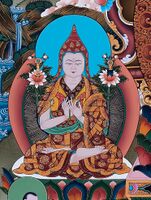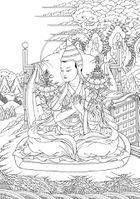Bu ston rin chen grub: Difference between revisions
No edit summary |
No edit summary |
||
| (10 intermediate revisions by 2 users not shown) | |||
| Line 1: | Line 1: | ||
{{Person | {{Person | ||
|MainNamePhon=Butön Rinchen Drup | |||
|SortName=Butön Rinchen Drup | |||
|MainNameTib=བུ་སྟོན་རིན་ཆེན་གྲུབ་ | |||
|MainNameWylie=bu ston rin chen grub | |||
|PersonType=Classical Tibetan Authors | |||
|images=File:Bu ston.jpg | |||
File:Buton (R. Beer).jpg{{!}}Line Drawing by Robert Beer Courtesy of [http://www.tibetanart.com/ The Robert Beer Online Galleries] | |||
|YearBirth=1290 | |||
|YearDeath=1364 | |||
|BornIn=khro phu (gtsang) | |||
|BdrcLink=https://www.tbrc.org/#!rid=P155 | |||
|TolLink=http://treasuryoflives.org/biographies/view/Buton-Rinchen-Drub/2845 | |||
|tolExcerpt=Butön Rinchen Drup, a Sakya lama raised in a Nyingma family, was the eleventh abbot of Zhalu Monastery, from 1320 to 1356. Some enumerations list him as the first abbot, as he significantly expanded the institution. He was an important teacher of the Prajñāpāramitā, and a key lineage holder of the Guhyasamāja and Kālacakra tantras as transmitted in the Geluk tradition, and the Kālacakra, Hevajra and Sampuṭa tantras as transmitted in the Sakya tradition. He is generally credited as the creator of the Tibetan Buddhist canon, the Kangyur and Tengyur, and his History of Buddhism is still widely read. In addition to his Sakya training he also studied in the Kadam and Kagyu traditions. | |||
|HasDrlPage=Yes | |HasDrlPage=Yes | ||
|HasLibPage=Yes | |HasLibPage=Yes | ||
| Line 5: | Line 18: | ||
|HasDnzPage=Yes | |HasDnzPage=Yes | ||
|HasBnwPage=Yes | |HasBnwPage=Yes | ||
| | |AltNamesWylie=bu ston kha che; bu ston thams cad mkhyen pa; | ||
|AltNamesOther=Buton Khache; Butön Tamche Khyenpa; Rinchen Drub | |||
| | |||
|TibDateGender=Male | |TibDateGender=Male | ||
|TibDateElement=Iron | |TibDateElement=Iron | ||
| Line 17: | Line 25: | ||
|TibDateRabjung=5 | |TibDateRabjung=5 | ||
|ReligiousAffiliation=Sakya | |ReligiousAffiliation=Sakya | ||
|TeacherOf=sgra tshad pa rin chen rnam rgyal; phyogs las rnam rgyal; bcu gnyis gsar ma grags pa shes rab; gangs dkar bla ma rin chen bzang po; 'jam dbyangs grags pa rgyal mtshan; g.yung ston rdo rje dpal bzang po; g.yag sde paN chen | |ClassicalProfAff=Zhalu Monastery (zhwa lu) | ||
|ClassicalOtherProfAff=Ripuk Hermitage (ri phug) | |||
|StudentOf=Dka' bzhi pa grags pa gzhon nu; | |||
|TeacherOf=sgra tshad pa rin chen rnam rgyal; phyogs las rnam rgyal; bcu gnyis gsar ma grags pa shes rab; gangs dkar bla ma rin chen bzang po; 'jam dbyangs grags pa rgyal mtshan; g.yung ston rdo rje dpal bzang po; g.yag sde paN chen; Byang chub rtse mo | |||
|PosBuNayDefProv=Provisional | |PosBuNayDefProv=Provisional | ||
|PosBuNayDefProvNotes=*[[Brunnhölzl, K.]], [[When the Clouds Part]], p. 67. | |PosBuNayDefProvNotes=*"Just as the Gelugpas, ''The Ornament That Illuminates and Beautifies the Tathāgata Heart'', by Butön Rinchen Drub (1290–1364), holds the teachings on buddha nature to be of expedient meaning." [[Brunnhölzl, K.]], ''[[When the Clouds Part]]'', p. 67. | ||
*[[Kano, K.]], [[Buddha-Nature and Emptiness]], p 364 | *"Bu-ston explicitly takes the Buddha-nature doctrine to be provisional (''neyārtha''). [[Kano, K.]], ''[[Buddha-Nature and Emptiness]]'', p. 364 | ||
|PosAllBuddha=Qualified No | |PosAllBuddha=Qualified No | ||
|PosAllBuddhaNote=Only Buddhas | |PosAllBuddhaNote=Only Buddhas | ||
|PosAllBuddhaMoreNotes=*"Taking the reverse position of the Gelugpas on this, both Butön and his student and commentator Dratsépa Rinchen Namgyal (1318–1388) identify the actual tathāgata heart as being solely the final fruition of buddhahood." [[Brunnhölzl, K.]], [[When the Clouds Part]], p. 67. | |PosAllBuddhaMoreNotes=*"Taking the reverse position of the Gelugpas on this, both Butön and his student and commentator Dratsépa Rinchen Namgyal (1318–1388) identify the actual tathāgata heart as being solely the final fruition of buddhahood." [[Brunnhölzl, K.]], ''[[When the Clouds Part]]'', p. 67. | ||
*"Bu-ston and his disciple sGra-tshad-pa assert that Buddha-nature should be understood only in its resultant aspect, namely as only the | *"Bu-ston and his disciple sGra-tshad-pa assert that Buddha-nature should be understood only in its resultant aspect, namely as only the dharmakāya of a buddha." [[Kano, K.]], ''[[Buddha-Nature and Emptiness]]'', p. 343. | ||
|PosEmptyLumin= | |PosYogaMadhya=Yogācāra | ||
|PosYogaMadhyaNotes=In line with his assertion that these teachings are merely provisional he claims, "The general basis of intention of the teachings on buddha nature is the ālaya-consciousness, which refers to the sheer cause of buddhahood." [[Brunnhölzl, K.]], ''[[When the Clouds Part]]'', p. 868. | |||
|PosZhenRang=Rangtong | |||
|PosZhenRangNotes=Though he didn't explicitly equate his position with Rangtong, he was certainly a vocal opponent of Dölpopa and his Zhentong view. | |||
|PosAnalyticMedit=Analytic Tradition | |||
|PosAnalyticMeditNotes=Though he differed from Ngok on certain issues, he was more in line with his approach than that of Tsen Khawoche. | |||
|PosEmptyLumin=Tathāgatagarbha as the Resultant State of Buddhahood | |||
|PosEmptyLuminNotes=Specifically, he sees buddha-nature as referring only to the dharmakāya of a fully enlightened buddha. | |||
*"Taking the reverse position of the Gelugpas on this, both Butön and his student and commentator Dratsépa Rinchen Namgyal (1318–1388) identify the actual tathāgata heart as being solely the final fruition of buddhahood." [[Brunnhölzl, K.]], ''[[When the Clouds Part]]'', p. 67. | |||
*"Bu-ston and his disciple sGra-tshad-pa assert that Buddha-nature should be understood only in its resultant aspect, namely as only the dharmakāya of a buddha." [[Kano, K.]], ''[[Buddha-Nature and Emptiness]]'', p. 343. | |||
|IsInGyatsa=No | |IsInGyatsa=No | ||
}} | }} | ||
Latest revision as of 15:03, 8 February 2023
| PersonType | Category:Classical Tibetan Authors |
|---|---|
| MainNamePhon | Butön Rinchen Drup |
| MainNameTib | བུ་སྟོན་རིན་ཆེན་གྲུབ་ |
| MainNameWylie | bu ston rin chen grub |
| SortName | Butön Rinchen Drup |
| AltNamesWylie | bu ston kha che · bu ston thams cad mkhyen pa |
| AltNamesOther | Buton Khache · Butön Tamche Khyenpa · Rinchen Drub |
| YearBirth | 1290 |
| YearDeath | 1364 |
| BornIn | khro phu (gtsang) |
| TibDateGender | Male |
| TibDateElement | Iron |
| TibDateAnimal | Tiger |
| TibDateRabjung | 5 |
| ReligiousAffiliation | Sakya |
| ClassicalProfAff | Zhalu Monastery (zhwa lu) |
| ClassicalOtherProfAff | Ripuk Hermitage (ri phug) |
| StudentOf | Kazhipa Drakpa Zhönu |
| TeacherOf | sgra tshad pa rin chen rnam rgyal · phyogs las rnam rgyal · bcu gnyis gsar ma grags pa shes rab · gangs dkar bla ma rin chen bzang po · 'jam dbyangs grags pa rgyal mtshan · g.yung ston rdo rje dpal bzang po · g.yag sde paN chen · Jangchup Tsemo |
| BDRC | https://www.tbrc.org/#!rid=P155 |
| Treasury of Lives | http://treasuryoflives.org/biographies/view/Buton-Rinchen-Drub/2845 |
| IsInGyatsa | No |
| PosBuNayDefProv | Provisional |
| PosBuNayDefProvNotes |
|
| PosAllBuddha | Qualified No |
| PosAllBuddhaNote | Only Buddhas |
| PosAllBuddhaMoreNotes |
|
| PosYogaMadhya | Yogācāra |
| PosYogaMadhyaNotes | In line with his assertion that these teachings are merely provisional he claims, "The general basis of intention of the teachings on buddha nature is the ālaya-consciousness, which refers to the sheer cause of buddhahood." Karl Brunnhölzl, When the Clouds Part, p. 868. |
| PosZhenRang | Rangtong |
| PosZhenRangNotes | Though he didn't explicitly equate his position with Rangtong, he was certainly a vocal opponent of Dölpopa and his Zhentong view. |
| PosAnalyticMedit | Analytic Tradition |
| PosAnalyticMeditNotes | Though he differed from Ngok on certain issues, he was more in line with his approach than that of Tsen Khawoche. |
| PosEmptyLumin | Tathāgatagarbha as the Resultant State of Buddhahood |
| PosEmptyLuminNotes | Specifically, he sees buddha-nature as referring only to the dharmakāya of a fully enlightened buddha.
|
| Other wikis |
If the page does not yet exist on the remote wiki, you can paste the tag |


